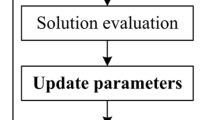Abstract
This paper investigates the receive antenna selection problem to maximize capacity in wireless MIMO communication system, which can be formulated as an integer programming optimization problem and can not be directly solved because of its non-convex characteristics caused by the discrete binary antenna selection factor. To deal with this challenge, a computationally efficient approach, particle swarm optimization(PSO) algorithm is introduced, in which the particle is defined as the discrete binary antenna selection factor and the objective function is associated with the capacity corresponding to the specified antenna subsection represented by the particle. Furthermore, in order to meet the condition that the number of selected antennas should keep fixed, the particle elements are relaxed to change between [0 1] and the position of the higher elements are taken as the index of the antenna subsection to be activated. Then the best antenna subset can be found by seeking the global optimal particle in PSO. Numerical results reveal that PSO algorithm exhibits a promising performance when applied to both the classical benchmark function and our antenna selection scenario.
Similar content being viewed by others
References
Gorokhov A., Gore D. A., Paulraj A. J. (2003) Receive antenna selection for MIMO spatial multiplexing: Theory and algorithms. IEEE Transactions on Siginal Processing 51(11): 2796–2807
Sanayei S., Nosratinia A. (2004) Antenna selection in MIMO systems. IEEE Communications Magazine 42(10): 68–73
Molisch A., Win M. (2004) MIMO systems with antenna selection. IEEE Microwave Magazine 5(1): 46–56
Kammoun, K., & Fontenelle, F. (2005). Antenna selection for MIMO systems based on an accurate approximation of QAM error probability. In Proceedings of IEEE vehicular technology conference (VTC) (pp. 206–210). Stockholm, Sweden.
Heath, R. W., & Paulraj, A. (2001). Antenna selection for spatial multiplexing systems based on minimum error rate. In Proceedings of IEEE international conference on communication (ICC) (pp. 2276–2280). Helsinki, Finland.
Dai L., Sfar S., Letaief K. B. (2006) Optimal antenna selection based on capacity maximization for MIMO systems in correlated channels. IEEE Transactions on Communication 54(3): 563–573
Khoa T., Phan C. T. (2007) Capacity analysis for transmit antenna selection using orthogonal space-time block codes. IEEE Communications Letters 11(5): 423–425
Mun C. (2006) Transmit-antenna selection for spatial multiplexing with ordered successive interference cancellation. IEEE Transactions on Communication 54(3): 423–429
Zhou Q., Dai H. Y. (2006) Joint antenna selection and link adaptation for MIMO systems. IEEE Transactions on Vehicular Technology 55(1): 243–255
Heath R., Sandhu S., Paulraj A. (2001) Antenna selection for spatial multiplexing systems with linear receivers. IEEE Communications Letters 5(4): 142–144
Yuan J. H. (2006) Adaptive transmit antenna selection with pragmatic space-time trellis codes. IEEE Transactions on Wireless Communications 5(7): 1706–1715
Gore D. A., Paulraj A. J. (2002) MIMO antenna subset selection with space-time coding. IEEE Transactions on Signal Processing 50(10): 2580–2588
Tansal, G., & Duman, T. M. (2007, June). Space-time coded systems with joint transmit and receive antenna selection. In Proceedings of IEEE international conference on communication (ICC) (pp. 5305–5310). Glasgow, Scotland.
Choi, Y. S., Molisch, A. F., Win, M. Z., & Winters, J. H. (2003, October). Fast algorithms for antenna selection in MIMO systems. In Proceedings of IEEE vehicular technology conference (VTC) (pp. 1733–1737). Florida, USA.
Dua A., Medepalli K., Paulraj A. J. (2006) Receive antenna selection in MIMO systems using convex optimization. IEEE Transactions on Wireless Communication 5(9): 2353–2357
Liu Y., Zhang Y. Y., Ji C. L., Malik W. Q. (2009) A low-complexity receive-antenna-selection algorithm for MIMO–OFDM wireless systems. IEEE Transactions on Vehicular Technology 58(6): 2793–2801
Lu H. Y., Fang W. H. (2007) Joint transmit/receive antenna selection in MIMO systems based on the priority-based genetic algorithm. IEEE Antennas and Wireless Propagation Letters 6: 588–591
Shu, F., & Ping, Z. (2008, May). Optimal multi-user MIMO linear precoding based on particle swarm optimization. In Proceedings of IEEE international conference on communication (ICC) (pp. 3355–3359). Beijing, China.
Shiu D. S., Foschini G. J., Gans M. J., Kahn J. M. (2000) Fading correlation and its effect on the capacity of multi-element antenna systems. IEEE Transactions on Communication 48(3): 502–513
Kennedy, J., & Eberhart, R. C. (1995, December). Particle swarm optimization. In Proceedings of IEEE international conference on neural networks (pp. 1942–1948). Perth, Australia.
Author information
Authors and Affiliations
Corresponding author
Rights and permissions
About this article
Cite this article
Yongqiang, H., Wentao, L. & Xiaohui, L. Particle Swarm Optimization for Antenna Selection in MIMO System. Wireless Pers Commun 68, 1013–1029 (2013). https://doi.org/10.1007/s11277-011-0496-z
Published:
Issue Date:
DOI: https://doi.org/10.1007/s11277-011-0496-z




